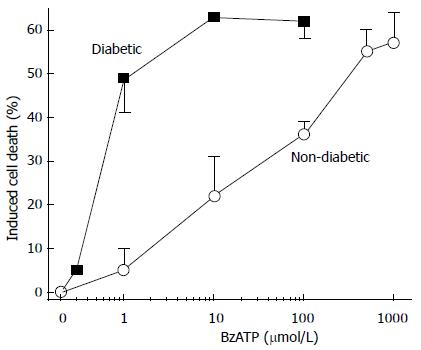Copyright
©2014 Baishideng Publishing Group Co.
World J Diabetes. Apr 15, 2014; 5(2): 141-145
Published online Apr 15, 2014. doi: 10.4239/wjd.v5.i2.141
Published online Apr 15, 2014. doi: 10.4239/wjd.v5.i2.141
Figure 1 Cell death induced in non-diabetic and diabetic retinal microvessels by the P2X7 agonist, benzoylbenzoyl adenosine triphosphate.
From Sugiyama et al[30] with permission from Investigative Ophthalmology and Visual Sciences. BzATP: Benzoylbenzoyl adenosine triphosphate.
Figure 2 Typical changes of electroretinography after intravitreal injection (IV) of benzoylbenzoyl adenosine triphosphate (50 nmol) or physiological saline solution in an alloxan-induced diabetic rabbit.
The amplitudes of a and b waves and oscillatory potentials were reduced in the BzATP-treated eye. From Sugiyama et al[32] with permission from Archives of Ophthalmology. BzATP: Benzoylbenzoyl adenosine triphosphate.
Figure 3 Models of the physiological and pathobiological effects of adenosine 5’-triphosphate in the retinal microvasculature.
A: Putative mechanisms regulating purinergic vasotoxicity; B: Putative mechanisms by which extracellular adenosine 5’-triphosphate (ATP) causes pericyte Ca2+ levels to rise and thereby the contraction of these mural cells and the constriction of adjacent lumens. From Sugiyama et al[33].
- Citation: Sugiyama T. Role of P2X7 receptors in the development of diabetic retinopathy. World J Diabetes 2014; 5(2): 141-145
- URL: https://www.wjgnet.com/1948-9358/full/v5/i2/141.htm
- DOI: https://dx.doi.org/10.4239/wjd.v5.i2.141











